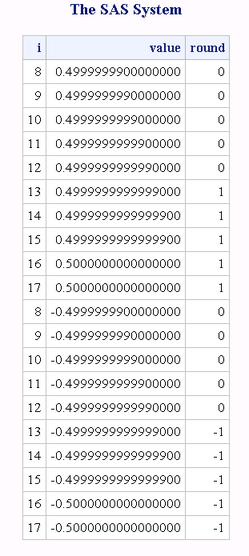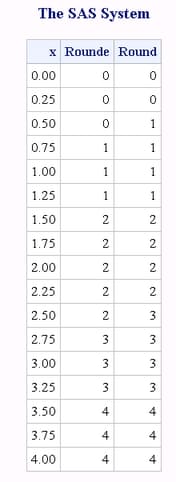ROUND Function
Rounds the first argument to the nearest multiple of the second argument, or to the nearest integer when the second argument is omitted.
| Category: | Truncation |
Details
Differences between Binary and Decimal Arithmetic
Computers use binary
arithmetic with finite precision. If you work with numbers that do
not have an exact binary representation, computers often produce results
that differ slightly from the results that are produced with decimal
arithmetic.
For example, the decimal
values 0.1 and 0.3 do not have exact binary representations. In decimal
arithmetic, 3*0.1 is exactly equal to 0.3, but this equality is not
true in binary arithmetic. As the following example shows, if you
write these two values in SAS, they appear the same. If you compute
the difference, however, you can see that the values are different.
data _null_; point_three=0.3; three_times_point_one=3*0.1; difference=point_three - three_times_point_one; put point_three= ; put three_times_point_one= ; put difference= ; run;
The Effects of Rounding
Rounding by definition
finds an exact multiple of the rounding unit that is closest to the
value to be rounded. For example, 0.33 rounded to the nearest tenth
equals 3*0.1 or 0.3 in decimal arithmetic. In binary arithmetic, 0.33
rounded to the nearest tenth equals 3*0.1, and not 0.3, because 0.3
is not an exact multiple of one tenth in binary arithmetic.
Expressing Binary Values
If the characters "0.3"
appear as a constant in a SAS program, the value is computed by the
standard informat as 3/10. To be consistent with the standard informat,
ROUND(0.33,0.1) computes the result as 3/10, and the
following statement produces the results that you would expect. if round(x,0.1) = 0.3 then
... more SAS statements ...However, if you use
the variable Y instead of the constant 0.3, as the following statement
shows, the results might be unexpected depending on how the variable
Y is computed.
if round(x,0.1) = y then
... more SAS statements ...If SAS reads Y as the
characters "0.3" using the standard informat, the result is the same
as if a constant 0.3 appeared in the IF statement. If SAS reads Y
with a different informat, or if a program other than SAS reads Y,
then there is no guarantee that the characters "0.3" would produce
a value of exactly 3/10. Imprecision can also be caused by computation
involving numbers that do not have exact binary representations, or
by porting data sets from one operating environment to another that
has a different floating-point representation.
Testing for Approximate Equality
You should not use the
ROUND function as a general method to test for approximate equality.
Two numbers that differ only in the least significant bit can round
to different values if one number rounds down and the other number
rounds up. Testing for approximate equality depends on how the numbers
have been computed. If both numbers are computed to high relative
precision, you could test for approximate equality by using the ABS
and the MAX functions, as the following example shows.
if abs(x-y) <= 1e-12 * max( abs(x), abs(y) ) then
... more SAS statements ...Producing Expected Results
In general,
ROUND(argument, rounding-unit) produces the result that
you expect from decimal arithmetic if the result has no more than
nine significant digits and any of the following conditions are true:
For example:
options pageno=1 nodate;
data rounding;
d1 = round(1234.56789,100) - 1200;
d2 = round(1234.56789,10) - 1230;
d3 = round(1234.56789,1) - 1235;
d4 = round(1234.56789,.1) - 1234.6;
d5 = round(1234.56789,.01) - 1234.57;
d6 = round(1234.56789,.001) - 1234.568;
d7 = round(1234.56789,.0001) - 1234.5679;
d8 = round(1234.56789,.00001) - 1234.56789;
d9 = round(1234.56789,.1111) - 1234.5432;
/* d10 has too many decimal places in the value for */
/* rounding-unit. */
d10 = round(1234.56789,.11111) - 1234.54321;
run;
proc print data=rounding noobs;
run;When the Rounding Unit Is the Reciprocal of an Integer
When the rounding unit
is the reciprocal of an integer, the ROUND function computes the result
by dividing by the integer. (ROUND treats the rounding unit as a reciprocal
of an integer if the reciprocal of the rounding unit differs from
an integer in at most the three or four least significant bits.) Therefore,
you can safely compare the result from ROUND with the ratio of two
integers, but not with a multiple of the rounding unit. For example:
options pageno=1 nodate; data rounding2; drop pi unit; pi = arcos(-1); unit=1/7; d1=round(pi,unit) - 22/7; d2=round(pi, unit) - 22*unit; run; proc print data=rounding2 noobs; run;
Computing Results in Special Cases
Computing Results When the Value Is Halfway between Multiples of the Rounding Unit
When the value to be
rounded is approximately halfway between two multiples of the rounding
unit, the ROUND function rounds up the absolute value and restores
the original sign. For example:
data test;
do i=8 to 17;
value=0.5 - 10**(-i);
round=round(value);
output;
end;
do i=8 to 17;
value=-0.5 + 10**(-i);
round=round(value);
output;
end;
run;
proc print data=test noobs;
format value 19.16;
run;Operating Environment Information: The example above was executed in a z/OS environment. If you use
other operating environments, the results might be slightly different.
Comparisons
The ROUND, ROUNDE, and
ROUNDZ functions are similar with four exceptions:
-
When the rounding unit is less than one and not the reciprocal of an integer, the result that is returned by ROUNDZ might not agree exactly with the result from decimal arithmetic. ROUND and ROUNDE perform extra computations, called fuzzing, to try to make the result agree with decimal arithmetic in the most common situations. ROUNDZ does not fuzz the result.
Example
The following example
compares the results that are returned by the ROUND function with
the results that are returned by the ROUNDE function. The output was
generated from the UNIX operating environment.
Copyright © SAS Institute Inc. All rights reserved.



